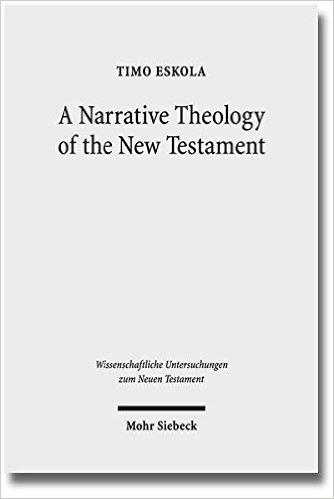A Narrative Theology of the New Testament: Exploring the Metanarrative of Exile and Restoration, by Timo Eskola, WUNT 350 (Mohr Siebeck, 2015), 477 pages.
In this work, Timo Eskola seeks to advance the restoration theme as a major substructure of NT theology. He recognizes that this new emphasis on restoration of Israel in NT thought was advanced largely by Sanders and Wright (8-11), but he believes no one has of yet demonstrated how the restoration paradigm undergirds all of NT theology.
Contents
To that end, he first begins with the message of Jesus, seeking strands of restoration thought in his teaching and sayings. Themes arise such as the Son of David as a builder of an eschatological temple, the tribulation as the end of exile, the jubilee, strict Jewish observance of the law, priestly purity in the community, the Lord’s Supper as a priestly meal, and a suffering Messiah as a sin offering for the corrupt exiles.
In part two he turns to early Christian teaching, looking at the events of Easter (and especially the role of Ps 110 in Christology), six Christological narratives he finds in early apostolic proclamation, and the interaction of early Christology and Jewish synagogal liturgy. These early hymns especially (the Amidah, the Benedictus, the Magnificat, and Stephen’s early preaching) demonstrate that the restoration of Israel is a major undergirding hope and dream for Jews around the first century.
The fourth chapter looks at the strands of restoration thought in Paul’s theology. He reads Paul eschatologically, in terms of fulfillment of OT hopes which brings liberation. He defends a more traditional view of justification over against the New Perspective as he looks at Paul’s critique of “works of the law.” He argues throughout that “Paul appears to be an expert in applying the metanarrative of exile and restoration in his theology” (271). One of the major themes of restoration in Paul’s thought is the gathering of the New Israel (373-386). One sees especially in Eskola’s synthesis that there is much in Paul’s thought that sees in Christ the restoration of Israel.
The fifth chapter examines restoration thought in the rest of the NT. The major themes he attempts to show are 1) the new temple in Hebrews, which was how Israel was to begin their restoration; 2) the celebration of the jubilee in the letter by James (“[t]his is a community where God raises the meek, debts are forgiven and sins are washed away” [395]); 3) the new creation and heavenly priesthood in the letters by Peter; 4) the reestablishment of the temple and the tribulation in John’s Gospel; 5) the release of the tribes of Israel in Revelation as well as the enthronement of the Son of David and the reestablishment of the garden-temple.
Critique
A work of this magnitude is difficult to write. Eskola has attempted to cover the entire NT and draw out the contours for a NT theology based on the subtext of exile and restoration. The problems immediately arise that 1) using this one theme is reductionistic and requires a multitude of other themes to fill out the picture, and 2) the exegetical work is insufficient. For example, the entire letter of 1 Peter gets a total of two pages, with the exegetical complexities of Peter’s use of OT passages to describe the church glossed over quickly. This does not mean that Eskola’s analysis is necessarily wrong, but that perhaps his scope was far too broad. The book should have been longer with more rigorous exegesis or more focused to one or two corpora.
Another problem is that there is no sustained discussion of the OT narrative itself. It rather comes in bits and pieces as Eskola is handling the different corpora. Indeed, we do discover the various strands of thought that are wrapped up with restoration, but we have no synthetic picture of restoration and all it entails as it arises from the narrative of the OT itself. I was bewildered that the work did not begin with a chapter detailing what exactly he means by restoration and exactly what prophesies were to be fulfilled when the restoration occurred. I was missing that kind of precision.
Nevertheless, the scope of the work is indeed impressive and it reads much like a volume on NT theology analyzing a single theme (similar to the New Studies in Biblical Theology series). It provides the reader a useful lens through which to view NT theology, and the OT theme of restoration provides another complex strand to weave into one’s picture of what second temple Jews cared about.
Preview of buy Eskola’s volume here on Amazon.



